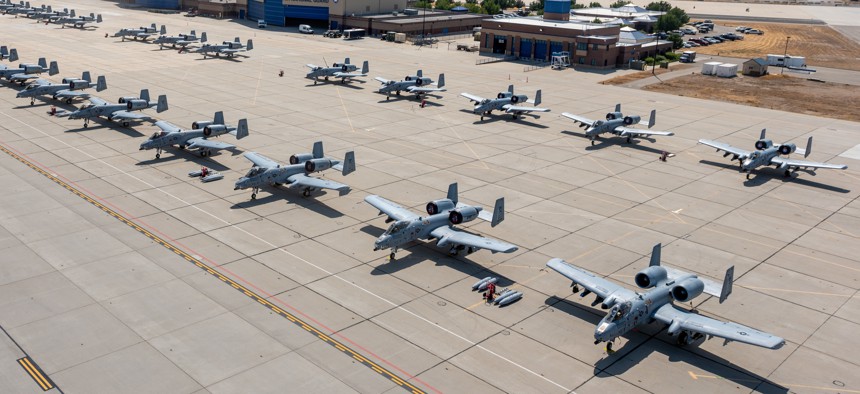
The flightline at Gowen Field, Boise, Idaho, hosted dozens of A-10 Thunderbolt IIs for the biennial Hawgsmoke 2022 tactical competition on Sept 8, 2022. U.S. Air National Guard / Staff Sgt. Mercedee Wilds
Air Force Wants Faster A-10 Retirements
21 Warthogs are going away this year, and service leaders hope Congress will allow more.
The Air Force wants to speed up the retirement of its remaining A-10 Warthogs to fund new weapons it says are better suited to counter China.
Service leaders have long sought to eliminate the almost half-century old plane, which has been repeatedly saved by lawmakers who argue that no other aircraft can protect ground troops so well. But after two decades of counterinsurgency in Afghanistan and Iraq, the U.S. no longer has a large number of ground forces deployed. The Air Force expects the battles of the future to be won by newer technology — including hypersonic missiles and stealth warplanes.
“I would say over the next five, six years we will actually probably be out of our A-10 inventory,” Gen. CQ Brown, the Air Force chief of staff, said Tuesday at an Air Force Association conference in Aurora, Colorado.
The Biden administration is poised to send its 2024 budget proposal to Congress in the coming days. Earlier in the day, Air Force Secretary Frank Kendall said the service wants to speed up new aircraft buys in 2024 and continue to retire older aircraft as it aims to “increase midterm capability and capacity.”
After years of rejections, Congress approved the Air Force’s request to retire 21 A-10s this year.
“We're gonna continue down that path,” Brown said, until the remaining 250 or so A-10s are gone.
He said combatant commanders—the generals and admirals who oversee U.S. military operations in different regions of the world—are not asking for A-10s. He noted that the A-10 is a single-mission aircraft and because fighters and bombers, equipped with satellite-and-laser-guided bombs, have been proven in close air support.
While Brown said the A-10 is a “great airplane in an uncontested environment,” Air Force leaders say the twin-jet is too vulnerable to surface-to-air missiles.
“We cannot predict the future of what kind of environment we're gonna fight in, but [we] fully expect to be much more contested. The amount of close air support we will do will probably be less than what we've done in the past, particularly in the Middle East because [in] that environment, we didn’t have an air threat, or a surface to air threat,” Brown said. “From that perspective, we’ve got to lean towards where the threat is.”
The A-10 was originally designed to destroy Soviet tank columns with its signature nose-mounted 30-millimeter cannon. Over the past year, Ukraine has reportedly asked U.S. leaders for 100 A-10s to help in its fight against Russia.
U.S. Special Operations Command is buying a fleet of propeller-driven attack planes to support troops on the ground.



